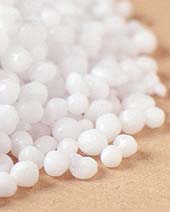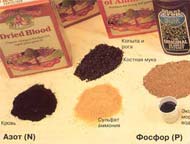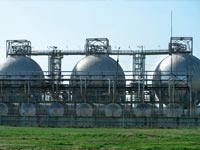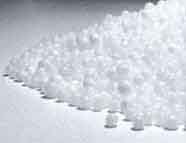 Mineral fertilizers
Mineral fertilizers
 Nitrogen and phosphate fertilizers
Nitrogen and phosphate fertilizers
 Storage of ammonia and phosphate fertilizers
Storage of ammonia and phosphate fertilizers
 Ammonium silistra
Ammonium silistra
There are mineral fertilizerss containing 1,2 and 3 nutrients, therefore are called simple, double and complex. In addition, some complex fertilizers also contain trace elements such as copper, boron, zinc, manganese. Fertilizer are stored in dry cool place, the shelf life is not limited, but preferably not more than 2 years.
Mineral fertilizerss applied to the soil in early spring or autumn before the preparation of the soil. During plant growth the fertilizers also add. (evenly scattered in dry form or watered).
Benefits of the elements contained in fertilizers
Thus, the lack of nitrogen in the soil causes the leaves lose color, become at first pale green, then turn yellow, stops the growth of new leaves, the some new leaves remain underdeveloped.
With a lack of potassium in the soil reduced the similarity of seeds, increases the susceptibility of plants to diseases, lower leaves first turn yellow in the edges, then turn brown and die.
Phosphorus is needed by plants to accelerate the development of the root system and fruit. The lack of phosphorus in the soil affects to the leaves, it are grayish or reddish color, the lower leaves turn yellow and die.
Calcium contributes to development of the root system. Sulfur "plays" a role in the processes of plant respiration; magnesium and iron, consumed by plants in much smaller quantities, also required for their normal development. Magnesium and iron supports the normal color of the leaves.
In addition to the described elements necessary for plants are boron, copper, manganese, zinc. In tomatoes grown in soils where there is no boron, growth stops, cauliflower and salad spots ere appear, resembling burns. In the absence of boron sensitive also cherries, apricots, apples and pears - they have stopped flowering and fruit ripening.
For depositing boron in soil fertilized with boric acid (H3BO3), it contains about 17% of boron, or brown - Na3BO3 about 11% boron. On 10m2 take 6 g of boric acid or 9 g of borax (you can mix them with other fertilizers).Each fertilizer has own dosage and usage rule.
With a lack of copper on the leaves of plants appear white spots, the leaves curl and dry up, stops the growth of plants. In addition, copper improves resistance of plants to fungal diseases and increase fruiting. To replenish the reserves of copper in the soil it make copper sulphate (CuSO4х5H2O), taking 10-20 grams of copper sulfate per 10 m2.
Manganese is an important role in respiration of plants and in the process of photosynthesis. Manganese increases the yield of agricultural plants.
Mineral fertilizers, which is the basis of manganese, used: fruit trees are sprayed before and after flowering with a solution containing 30 g of potasium permanganate with 1 liter of water. This can be combined with "Urea". In the main for vegetable crops take 60-100 g of potassium permanganate in 10 m2 square.
Zinc has beneficial effects to formation organic acids in plants from carbohydrates and prevents a number of diseases of plants, especially citrus.
Of course, it's best to use a complex fertilizers, containing a complete set of trace elements (boron, manganese, molybdenum, zinc, copper), and 11% of nitrogen, phosphorus and potassium. Such fertilizers are suitable for all soil types and are used for the main application.
Phosphate fertilizers
Phosphate fertilizers - the most common are superphosphate, precipitate and phosphate rock.Simple superphosphate is a mixture of calcium dihydrogen phosphate Ca(H2PO4)2, calcium hydrophosphate CaHPO4 and calcium phosphate Ca3(PO4)2 and also apatite, gypsum, and other impurities. Simple superphosphate is got with processing phosphorites and appatity with sulfuric acid. When processing mineral phosphate with phosphoric acid get double superphosphate, containing up to 50% of phosphorus oxide (P2O5). During the mixing phosphoric acid with lime get precipitate CaHPO4 x 2H2O
The phosphate fertilizers include:
Ca3(PO4)2 phosphate rock, bone meal
Ca(H2PO4)2 + 2CaSO4 - simple superphosphate
Ca(H2PO4)2 - double superphosphate
CaHPO4x2H2O - precipitate
NH4H2PO4+NH4)2HPO4 - mofos - complex fertilizer
Nitrogen fertilizers:
NH3 - ammonia (contains the largest mass fraction of nitrogen)
NH3xH2O - ammonia water
CO(NH2)2 - urea
NH4NO3 ammonium nitrate
KNO3 - potassium nitrate (indian)
NaNO3 sodium nitrate (chilean)
Ca(NO3)2 - calcium nitrate (norwegian)
Potassium fertilizers:
NaCl x KCl - Silvinit
KCl - sylvite (potassium salt)
K2SO4 is the potassium sulfate
K2SB3 - potash, wood ash, peat ash
Indicator pH. Color of indicator
Crystal growing. How to grow crystal
Color glass. The crystal. Quartz glass
Cooling mixture. Endothermic reaction
Natural soap. The composition of natural Soaps
The composition of toothpaste. Structure of cream
Aromatic substances
How to strengthen the smell of perfume
Structure of paint
Mineral paint
Chemistry tasks. Solve simple! Examples
Removal of corrosion with different metals
Photo on the metal. Photo on fabric
Solid grease.liquid grease. Grease properties
Resin. Phenol-formaldehyde resin
Ammonia. Properties of ammonia
Bases. Properties of bases. Alkali
Enzymes. The action of enzymes
Building solutions. Preparation of building solutions
Solutions. Colloidal solutionsToilet soap. Making soap at home